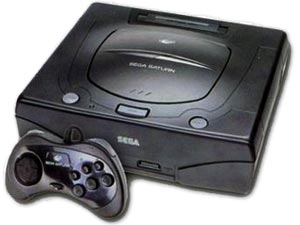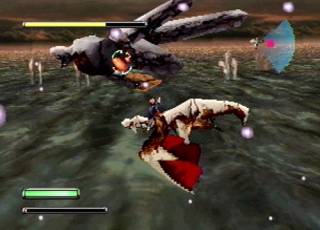Overview
 Sega Saturn Console.
Sega Saturn Console.The Sega Saturn was released in 1994 in Japan, followed by worldwide release in 1995, and offered gamers 32-bit gameplay. The console was the successor to the Mega Drive (known as the Genesis in North America). Estimates for the Saturn's worldwide sales range from 9.5 million units to 17 million units.
Sega developers worked two full years on the Saturn's hardware. At the time, the Saturn was a powerhouse with two CPU's and six more processors. The Saturn was a very complex machine as some of its parts were not designed to work together. The Saturn was originally designed to have a single main processor, with 2D and pseudo-3D graphics similar to the Sega System 32 arcade board and 3D graphics similar to the Sega Model 1 arcade system. However, after learning the 3D capabilities of the new Playstation (in turn influenced by Sega's own AM2-developed Virtua Fighter in the arcades), the Sega Team added a new processor to increase 3D graphical performance.
When it came to 2D and pseudo-3D graphical capabilities, the Saturn had the most powerful sprite and background manipulation capabilities of its generation. When it came to 3D polygons, it had more power than the PlayStation but was more difficult to use.
Part of the reason for the system's failure was the complex graphics hardware, which was often difficult to work with. Many ports that came to the Saturn were downgraded and completely rewritten. It was also optimised for assembly language rather than the more popular C language, which resulted in the use of C slowing down performance by several times compared to assembly. The Saturn was also mainly designed around quad polygons, for greater compatibility with 2D graphics, rather than triangle polygons, the more popular choice for 3D graphics. As a result of these design decisions, third-party support outside of Japan was very thin for the Sega Saturn.
Success in Japan
The Sega Saturn was rushed to the Japanese market in November of 1994. As a result of the difficulty to make games for the Sega Saturn, as well as the rushed release, very few games were available at the Saturn's launch. In Japan, the Saturn sold around 170,000 units on launch day. Despite being outsold by the PlayStation, the Saturn's software had more sales than the Playstation's software did at the time. By the end of 1996, the Saturn's hardware sales in Japan were only 600,000 units behind the PlayStation, before the PlayStation pulled ahead in following years (especially after Final Fantasy VII).
Despite the PlayStation's lead, the Saturn went on to become Sega's most successful console in Japan, where it was the runner-up and outsold the Nintendo 64. The Saturn's success in Japan was largely due to its large, diverse library of games, most of which were released exclusively in Japan and never made it to Western markets. These included action games such as various Virtua and Street Fighter titles, visual novels such as YU-NO and Machi, and RPG's such as Sakura Wars, Lunar, Grandia, etc.
The console's success in Japan was also partly due to Sega's marketing campaign, which largely revolved a new mascot character called Segata Sanshiro (a parody of the classic Akira Kurosawa film & character, Sugata Sanshiro), who was never promoted outside of Japan.
Lack of Overseas Success
 Panzer Dragoon Zwei.
Panzer Dragoon Zwei.In North America, the set release date of the Saturn was originally September 2, 1995, one week before the release of the Playstation. This day was called "Saturnday," since September 2 fell on a Saturday that year. However, at E3 in 1995, Sega of America President Tom Kalinske was forced to announce an early release. The new release date was May 11, 1995, a good four months before the Playstation was to be released. This hurt the Saturn far more than it helped it. The Saturn ended up costing $100 USD more than the Playstation, and since most of the Saturn's third-party games were still scheduled to be released at the original launch date, the Saturn had very few launch titles. Many say this was a large factor in the Sega Saturn's eventual failure. The Saturn sold only 80,000 units by the time of the Playstation launch; in contrast, the Playstation sold 100,000 units upon its own launch. As a result of clashes with Sega of Japan about the management of Sega of America, the Saturn launch, and other issues, Tom Kalinske resigned in 1996. Bernie Stolar, Kalinske's replacement, would become a controversial figure after stating at E3 in 1997 that the Saturn was not Sega's future.
Meanwhile in Europe, Sega systems had ruled the market since the 1980's. The Master System and Mega Drive (known as Genesis in North America) were the top-selling consoles in Europe. However, when the Saturn was released in Europe in July 1995, the hype for the Playstation's upcoming release led to low Saturn sales there as well. This was the first time Sega had lost its lead in the European market, which it had previously dominated since the 8-bit era.
Later years
There were many different versions of the console. Sega allowed some companies who helped to make the Saturn to release their own versions of the console. Companies like Hitachi, JVC, and Samsung released their own Saturns with special features. In Japan, there were nine different models made by four different developers. In North America, there were only three models, all of which were made by Sega. In Europe and Australia, there were two models, both made by Sega.
By the end of the Saturn's overseas lifespan in 1998, about 470 games had been released. The final games released in 1997 and 1998, most notably Panzer Dragoon Saga, had low production numbers because of the system's impending demise. As a result, these games typically have high prices today, with Panzer Dragoon Saga regularly selling for $200 on eBay. By the end of the Saturn's Japanese lifespan in 2000, the console had nearly 600 games released, a majority of which were exclusive to Japan.
The system featured an option for memory expansion. There was a slot behind the CD tray where a storage card could be placed to save high scores, save files, and other data.
Netlink and Online Play
 Saturn Net Link Device.
Saturn Net Link Device.The Netlink modem was a cartridge that fit into the back cartridge slot of the Saturn (where the memory card fit into the system) and ran at a speed of 28.8 kbit/s connection in America and 14.4 kbit/s in Japan. It used a dial-up service, since broadband was unavailable at the time. There were web browsers available for navigating the Internet on the Saturn, but they were not used often. In Europe the Netlink modem was only released in Finland, where it was available with a localized web browser.
There were five games that supported the modem:
These games are playable online even today because of the direct-dial support built into the modem. It uses the phone line in any home with the regular phone cable and, in a sense, "calls" the other Saturn console, regardless of its location within the same country. Since it uses the phone line, anyone who tries calling that number will be told that it is busy or in use. These games can only be played head-to-head. For its time, this was a large technological advance, especially considering the earlier XBAND service for both the Mega Drive / Genesis and Super Famicom / SNES.
U.S Launch Titles
The Saturn had an extremely limited launch lineup in America, because developers were uninformed of the surprise launch, and their games weren't ready yet. The following are U.S launch titles for the Sega Saturn released on May 11, 1995:
Hardware Specifications
Due to Sega's arcade heritage, Sega Saturn has multiple processors for specific operations. This made it difficult for many developers, particularly those outside of the arcade industry, to develop games for the console.
Processors
CPU
- Main CPU: 2x Hitachi SH-2 (32-bit RISC) @ 28.6364 MHz (56.072 MIPS)
- CD-ROM controller: Hitachi SH-1 (32-bit RISC)
- Sound controller: Motorola 68EC000 (16/32-bit CISC) @ 11.3 MHz (2 MIPS)
- MCU: Hitachi 4-bit MCU
GPU
- Foreground GPU: Sega VDP1 (32-bit) @ 28.6364 MHz
- Background GPU: Sega VDP2 (32-bit) @ 28.6364 MHz
Sound processors
- Sound chip: Yamaha YMF292/SCSP (Saturn Custom Sound Processor)
- Audio co-processor: Custom Saturn Control Unit (32-bit)
- DSP: Yamaha FH1 (24-bit DSP) @ 22.6MHz
Graphics
VDP1: 32-Bit Video Display Processor Operations
- Features: Sprite/texture/polygon geometry system, texture mapping, Gouraud shading
- Frame buffers: Dual 256 KB (512 KB)
- Frame buffer resolutions: 512x256, 512x512, 1024x256
- Sprite/texture cache: 512 KB
- Texture-mapped polygons per second: 200,000
- Flat-shaded polygons per second: 500,000
- Sprites/textures per frame: 16,384
- Sprites/textures per second: 983,040
- Sprites/textures per scanline: 512
- Sprite/texture size: 8x1 to 504x255 pixels
- Colors per sprite/texture: 16 (4-bit), 64 (6-bit), 128 (7-bit), 256 (8-bit), 32,768 (15-bit high color)
- Texels per second: 28,636,400 (28.6364 MHz video clock cycles)
- Texels per frame: 954,546
- Texels per scanline: 4096
VDP2: 32-bit Background & Scrolling Operations
- Screen resolution: 320x224 to 720x480 (progressive), 320x448 to 720x576 (interlaced)
- Colors on screen: 16,777,216 (24-bit true color)
- Scrolling playfields/backgrounds: 5 planes (2 with scaling)
- Rotational playfields/backgrounds: 2 planes (both with scrolling & scaling)
- Background mapping: Tilemap for 3-6 planes, bitmap for 1-4 planes
- Background resolution: 512x512 to 1024x1024 (tilemap), 512x256 to 1024x512 (bitmap)
- Colors per background: 16 (4-bit), 256 (8-bit), 32,768 (15-bit), 16,777,216 (24-bit)
- Possible A/V outputs: Composite, S-Video, Component (RGB), SCART (RGB)
Sound
- Sound channels: 32, each capable of operating as FM synthesis or PCM channel
- PCM audio depth: 16-bit
- PCM sampling rate: 44.1KHz (CD quality)
- DSP: Yamaha FH1 (embedded 128-step programmable audio effect DSP)
Memory
Internal ROM: 512 KB
Internal RAM: 4.5 MB (1 MB SDRAM, 2 MB DRAM, 1.5 MB VRAM)
- Main RAM: 1 MB SDRAM (fast), 1 MB DRAM (standard)
- VDP1 fast VRAM: 512KB sprite/texture cache, 512 KB framebuffers
- VDP2 fast VRAM: 512 KB backgrounds
- Sound memory: 512 KB DRAM
- CD cache memory: 512 KB DRAM
 Sega Saturn 1MB/4MB RAM cart Pro Action Replay.
Sega Saturn 1MB/4MB RAM cart Pro Action Replay.Note about memory: 3 different types of memory expansion carts (which used the Saturn's standard cartridge slot) were released for the Japanese Saturn: ROM cartridges for the games King of Fighters '95, King of Fighters '96 '95, King of Fighters Best Collection, and an Ultraman game; a 1 MB RAM cart which was used for many SNK fighting games, including Metal Slug, Samurai Spirits Best Collection, and King of Fighters '97, and also a few Capcom games, including Cyberbots: Full Metal Madness, and Marvel Super Heroes; and a 4MB RAM cartridge used by several companies, most notably Capcom, with games like Marvel Super Heroes vs. Street Fighter, X-Men vs. Street Fighter, Vampire Savior, the second disc in the two-disc Dungeons and Dragons Collection, Shadow Over Mystara, and the poorly-received Final Fight: Revenge, which was the last game officially released on the Saturn (more than 6 months after the Dreamcast's US launch).
CD-ROM
- 2x Functioning Speed
- CD-DA Capable (allows Audio CD Playback)
- CD G Capable
- CD EG Capable
- Video CD Capable (Optional Add-On)
- Photo CD Capable (Optional Add-On)
- Transfer rate: 330 KB per second
- Audio bit rate: 150 KB per second
Log in to comment